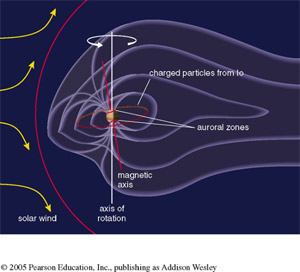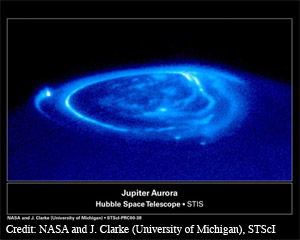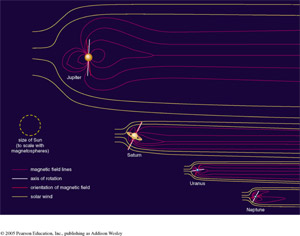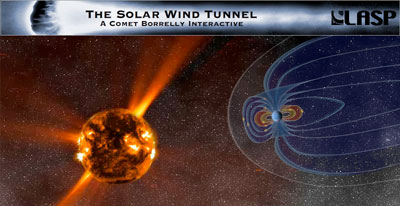
MagnetospheresMagnetospheres
SUMMARY: All four jovian planets have surrounding magnetic fields that create magnetospheres in response to pressure from the solar wind.
Jupiter's Magnetosphere
Comparing Jovian Magnetospheres
The Io Torus
Related links
Related Lessons:
Terra Bagga
Jupiter's Magnetosphere
The stronger the magnetic field, the larger the magnetosphere. Some 20,000 times stronger than Earth's magnetic field, Jupiter's magnetic field creates a magnetosphere so large it begins to avert the solar wind almost 3 million kilometers before it reaches Jupiter. The magnetosphere extends so far past Jupiter it sweeps the solar wind as far as the orbit of Saturn.
Like Earth's magnetosphere, many of the charged particles trapped in Jupiter's magnetosphere come from the solar wind; however, Jupiter has an extra source of particles that other planets do not have. Jupiter's volcanically active moon, Io, provides a substantial portion of charged particles to Jupiter's magnetosphere.
These charged particles can spiral along the planetary magnetic field lines into the upper atmosphere and around the magnetic poles. When these energetic particles, usually electrons, collide with atoms and molecules in the atmosphere they transfer energy. This energy is then released, sometimes in the form of visible light. This is the same process that produces the different colored auroras we see on Earth. Jupiter also has auroras on its north and south poles.
Io and the other Galilean moons are affected by Jupiter's magnetosphere. The charged particles trapped around the planet occasionally hit the surfaces of the moons, releasing some atoms and molecules which sometimes create a thin atmosphere around the moon.
Comparing Jovian Magnetospheres
A global magnetic field is created when the object's interior has convection in a region of electrically conducting fluid. In Jupiter, this region is the large layer of metallic hydrogen, seen in the picture. Saturn's layer of metallic hydrogen is smaller than Jupiter's, and the strength of Saturn's magnetic field is proportionally smaller. The amount of electrically conducting fluid dictates the strength of a planet's magnetic field: more fluid = stronger magnetic field. Both Uranus and Neptune lack metallic hydrogen in their interiors, but are still surrounded by weak magnetic fields. It is thought that these magnetic fields stem from the planet's hydrogen compound cores.
A planet's magnetosphere forms as the internal pressure of the planet's magnetic field interacts, and balances with the external pressure of the solar wind. Thus, the size of a planet's magnetosphere depends on both the strength of the magnetic field and the strength of the solar wind. Jupiter's magnetosphere is by far the largest in our solar system.
The Solar Wind Tunnel
The Io Torus

(click to enlarge)
Io, the closest orbiting moon of Jupiter, is the most volcanically active moon in the solar system. Io's volcanic plumes spew sulfurous material over 500 km above the surface. Most of these particles are moving at speeds high enough to be ejected into space. They are stripped of their electrons, creating ions, when they interact with Jupiter's magnetic field.

(click to enlarge)

(click to enlarge)
Io is orbiting so close to Jupiter that Jupiter's magnetosphere actually interacts with Io. When the magnetosphere rotates past Io, it collects some of the ions and gases spewed from Io's volcanoes. Since the field is rotating around the planet, the particles also rotate around the planet, effectively making a ring around Jupiter. This ring of gas is called the Io torus.
Jupiter Atmosphere Images at LASP






